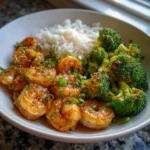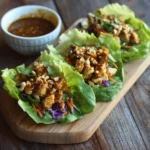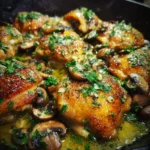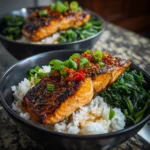Thai Coconut Curry Noodles with Chicken: A Flavorful Journey Through Southeast Asia
Indulge in the rich, creamy, and aromatic flavors of Thai Coconut Curry Noodles with Chicken—a dish that perfectly balances spicy, sweet, savory, and tangy notes. This beloved recipe brings together the essence of Thai street food and home cooking, transforming simple ingredients into a vibrant, satisfying meal. Whether you’re craving comfort after a long day or looking to explore authentic Thai-inspired cuisine, this dish delivers an explosion of taste with every bite. From its historical roots to modern-day adaptations, let’s dive deep into everything you need to know about crafting the perfect bowl of Thai Coconut Curry Noodles with Chicken.
The History
Thai cuisine has centuries of culinary evolution rooted in trade, regional diversity, and cultural exchange. The use of coconut milk in curries dates back to southern Thailand, where coconuts grow abundantly along tropical coastlines. Historically, coconut milk was used as a base for curries to mellow out the intense heat of chilies while adding richness and body. Over time, Indian, Chinese, and Malay influences shaped Thai curry traditions, introducing spices like cumin, coriander, turmeric, and galangal.
Curry noodles, known locally as kuaitiao, became popular as quick meals sold by street vendors across Bangkok and Chiang Mai. These portable dishes combined rice or egg noodles with fragrant broths, proteins, and fresh herbs. The version we now enjoy—Thai Coconut Curry Noodles with Chicken—is a fusion of traditional red or green curry paste techniques with noodle soup culture. It reflects both rural authenticity and urban innovation, making it a staple not only in Thailand but also in households around the world seeking bold, balanced flavors.
Ingredients Breakdown
Creating an authentic yet approachable Thai Coconut Curry Noodles with Chicken starts with understanding each ingredient’s role. Here’s a detailed look at what goes into this flavorful dish:
- Chicken Breast or Thighs: Boneless, skinless chicken is ideal. Thighs offer more moisture and flavor due to higher fat content, while breasts are leaner and cook quickly.
- Coconut Milk: Full-fat canned coconut milk provides the luxurious creaminess essential for authentic texture and flavor. Light coconut milk can be used for a thinner consistency, but full-fat yields better results.
- Curry Paste: Red or yellow Thai curry paste (store-bought or homemade) contains dried chilies, lemongrass, garlic, shallots, galangal, and shrimp paste. Choose based on preferred spice level—red is spicier; yellow is milder and slightly sweeter.
- Rice Noodles: Flat rice noodles (like pad thai noodles) or thin vermicelli work best. They absorb flavors well without becoming mushy.
- Fresh Aromatics: Garlic, ginger, and lemongrass add depth. Sliced shallots or red onion contribute crunch and sweetness.
- Fish Sauce: A cornerstone of Thai seasoning, fish sauce adds umami and saltiness. Use high-quality brands for cleaner taste.
- Palm Sugar or Brown Sugar: Balances the heat and acidity. Palm sugar offers a deeper caramel-like note, but brown sugar works well too.
- Lime Juice: Freshly squeezed lime juice brightens the entire dish, cutting through the richness of the coconut milk.
- Vegetables: Common additions include bell peppers, zucchini, baby corn, mushrooms, bok choy, or spinach. These enhance nutrition and color.
- Cilantro and Thai Basil: Fresh herbs elevate aroma and freshness. Thai basil has a licorice-like flavor distinct from sweet basil.
- Chili Oil or Fresh Chilies: For extra heat lovers, sliced bird’s eye chilies or chili oil can be added at the end.
- Toasted Coconut Flakes or Crushed Peanuts: Optional garnishes that add texture and nutty flavor.
Step-by-Step Recipe
- Prepare the Noodles: Soak rice noodles in warm water according to package instructions (usually 20–30 minutes). Drain and set aside. If using pre-cooked noodles, rinse under cold water to prevent sticking.
- Sauté the Aromatics: In a large pot or wok, heat 1 tablespoon of vegetable oil over medium heat. Add 3 minced garlic cloves, 1 tablespoon grated ginger, and 1 stalk of finely chopped lemongrass (white part only). Stir-fry for 1–2 minutes until fragrant.
- Bloom the Curry Paste: Add 2–3 tablespoons of Thai red or yellow curry paste. Cook for 2–3 minutes, stirring constantly, to release essential oils and deepen the flavor.
- Add Coconut Milk: Pour in 1 can (400 ml) of full-fat coconut milk. Whisk gently to combine with the curry paste. Bring to a gentle simmer, allowing the mixture to thicken slightly (about 5 minutes).
- Season the Broth: Stir in 1–2 teaspoons of fish sauce, 1 tablespoon of palm sugar, and the juice of half a lime. Taste and adjust—add more sugar for sweetness, lime for tang, or fish sauce for saltiness.
- Cook the Chicken: Slice 1 lb (450g) of chicken into thin strips. Add to the simmering curry broth and cook for 6–8 minutes, or until fully cooked through and no longer pink inside.
- Add Vegetables: Toss in your choice of vegetables—such as sliced bell peppers, halved baby corn, or chopped bok choy. Simmer for another 4–5 minutes until tender-crisp.
- Incorporate Noodles: Add the drained rice noodles to the pot. Gently toss to coat them evenly with the curry sauce. Heat through for 2–3 minutes.
- Finish with Herbs: Remove from heat. Stir in a handful of torn Thai basil leaves and chopped cilantro. Adjust seasoning one final time.
- Serve Immediately: Ladle the hot curry noodles into bowls. Garnish with additional herbs, sliced chilies, lime wedges, and optional crushed peanuts or toasted coconut flakes.
Tips
- Use Homemade Curry Paste When Possible: While store-bought pastes are convenient, making your own allows control over ingredients and intensity. Blend lemongrass, galangal, garlic, shallots, dried chilies, shrimp paste, coriander seeds, and cumin for a fresher, more complex flavor.
- Don’t Boil Coconut Milk Vigorously: High heat can cause separation. Keep the temperature low to medium when simmering to maintain a smooth, creamy texture.
- Soak Noodles Properly: Avoid over-soaking, which leads to mushy noodles. Test tenderness early and drain promptly.
- Bloom the Paste Well: Cooking the curry paste in oil before adding liquids enhances depth and removes rawness.
- Balancing Flavors Is Key: Thai cuisine thrives on harmony. Always taste and adjust the quartet of flavors: salty (fish sauce), sweet (sugar), sour (lime), and spicy (chilies).
- Prep Ahead: Chop all ingredients before starting. This stir-and-simmer process moves quickly once the curry paste hits the pan.
- Reserve Some Garnishes Raw: Adding fresh herbs and crunchy toppings just before serving ensures maximum aroma and texture contrast.
Variations and Customizations
This recipe is highly adaptable to dietary preferences and available ingredients. Consider these creative twists:
- Vegan Version: Substitute chicken with tofu or tempeh, use vegan fish sauce or soy sauce, and ensure curry paste is free from shrimp paste.
- Seafood Twist: Replace chicken with shrimp, scallops, or chunks of white fish. Add seafood during the last few minutes of cooking to avoid overcooking.
- Different Noodles: Swap rice noodles for udon, soba, or even glass noodles (cellophane noodles) for varied textures.
- Green Curry Style: Use green curry paste instead of red for a brighter, grassier flavor profile with more herbal notes.
- Spice Level Control: Reduce curry paste amount for mild versions or increase with fresh bird’s eye chilies for extreme heat.
- Nut-Free Option: Skip peanut garnish and check curry paste labels for potential nut contamination if allergies are a concern.
- Low-Carb/Keto Adaptation: Serve over spiralized zucchini (zoodles) or shirataki noodles. Increase healthy fats with extra coconut milk or avocado slices.
- Extra Creamy Version: Stir in a spoonful of coconut cream at the end for an even richer mouthfeel.
Health Considerations and Nutritional Value
A typical serving of Thai Coconut Curry Noodles with Chicken (approx. 1.5 cups) contains roughly:
- Calories: 450–550 kcal
- Protein: 25–30g (from chicken and fish sauce)
- Fat: 25–30g (mostly from coconut milk—contains saturated fat, but primarily medium-chain triglycerides [MCTs] linked to metabolic benefits)
- Carbohydrates: 35–45g (mainly from rice noodles and vegetables)
- Fiber: 3–5g (from veggies and some whole grain alternatives)
- Sodium: 800–1200mg (can be reduced by using low-sodium fish sauce or limiting added salt)
Health Benefits:
- Coconut milk contains lauric acid, which may support immune function.
- Garlic, ginger, and lemongrass have anti-inflammatory and antimicrobial properties.
- Fish sauce provides trace minerals like iodine and selenium.
- Vegetables boost vitamin intake (A, C, K) and antioxidants.
Considerations:
- Due to its saturated fat content, consume coconut milk in moderation if managing cholesterol levels.
- Monitor sodium intake, especially for those with hypertension—opt for reduced-sodium fish sauce or dilute with water.
- Balance the meal with a side salad or steamed greens for added fiber and nutrients.
Ingredients
- 1 lb (450g) boneless, skinless chicken breast or thighs, thinly sliced
- 1 can (400 ml) full-fat coconut milk
- 2–3 tbsp Thai red or yellow curry paste (adjust to taste)
- 8 oz (225g) dried rice noodles (flat or vermicelli)
- 3 cloves garlic, minced
- 1 tbsp fresh ginger, grated
- 1 stalk lemongrass, finely chopped (use only the tender white part)
- 1 medium red bell pepper, thinly sliced
- 1 cup baby corn, halved
- 2 cups bok choy or spinach, chopped
- 2 tbsp fish sauce (or substitute with soy sauce for gluten-free/vegan option)
- 1 tbsp palm sugar or brown sugar
- Juice of ½–1 lime (about 1–2 tbsp)
- 2 tbsp vegetable oil (coconut, sunflower, or canola)
- ½ cup fresh cilantro, chopped
- ¼ cup Thai basil leaves, torn
- Optional garnishes: sliced red chilies, crushed roasted peanuts, toasted coconut flakes, lime wedges
Directions
- Place rice noodles in a large bowl and cover with warm water. Let soak for 20–30 minutes, or until pliable and tender. Drain thoroughly and rinse with cold water to stop cooking. Set aside.
- Heat oil in a large pot or deep skillet over medium heat. Add garlic, ginger, and lemongrass. Sauté for 1–2 minutes until aromatic.
- Add curry paste and cook, stirring frequently, for 2–3 minutes to toast the spices and develop flavor.
- Pour in the coconut milk, whisking to blend with the curry base. Bring to a gentle simmer and let cook for 5 minutes, allowing the sauce to thicken slightly.
- Stir in fish sauce, sugar, and lime juice. Taste and adjust seasoning—aim for a balance of salty, sweet, sour, and spicy.
- Add chicken pieces to the simmering sauce. Cook uncovered for 6–8 minutes, stirring occasionally, until chicken is cooked through and juices run clear.
- Add bell pepper, baby corn, and bok choy (or spinach). Simmer for 4–5 minutes until vegetables are crisp-tender.
- Add the soaked rice noodles to the pot. Gently toss everything together to coat noodles evenly with sauce. Heat for 2–3 minutes until warmed through.
- Remove from heat. Stir in most of the cilantro and Thai basil, reserving some for garnish.
- Serve immediately in bowls. Top with remaining herbs, sliced chilies, crushed peanuts, toasted coconut, and lime wedges on the side.
FAQ
Can I make this ahead of time?
Yes, you can prepare the curry base and cook the chicken in advance. Store separately from noodles and reheat when ready. Assemble just before serving to prevent sogginess.
What kind of rice noodles should I use?
Flat rice noodles (similar to those used in pad thai) or thin rice vermicelli both work well. Choose based on texture preference—flat noodles are heartier; vermicelli are delicate.
Is this dish gluten-free?
Typically yes, but always check labels. Some curry pastes and fish sauces contain gluten or are processed in facilities with wheat. Use certified gluten-free products if necessary.
How do I store leftovers?
Store in an airtight container in the refrigerator for up to 3 days. Reheat gently on the stove with a splash of water or coconut milk to loosen the sauce.
Can I freeze Thai Coconut Curry Noodles?
Freezing is possible, but the texture of coconut milk may separate upon thawing. Re-blend or whisk vigorously when reheating. Noodles may become softer after freezing.
Why is my curry oily?
This can happen if the coconut milk separates due to high heat or prolonged simmering. To fix, whisk in a little warm water or broth and reduce heat next time.
What can I serve alongside this dish?
Pair with a fresh cucumber salad, mango slaw, or steamed jasmine rice. A cold Thai iced tea complements the spiciness beautifully.
Summary
Thai Coconut Curry Noodles with Chicken is a harmonious blend of creamy coconut milk, fragrant spices, tender protein, and vibrant vegetables—all brought together with aromatic herbs and perfectly cooked noodles. This versatile, restaurant-quality dish can be customized for various diets and tastes, making it a go-to favorite for weeknight dinners or special gatherings alike.










